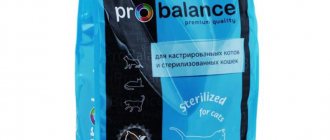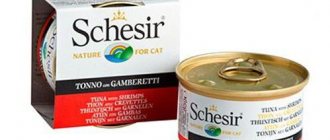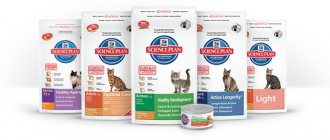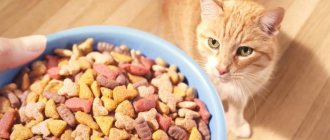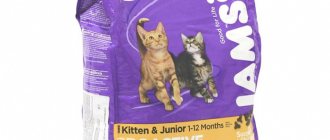What vitamins do cats need?
If your pet’s diet is fairly uniform, constantly consisting of the same familiar foods (for example, poultry and some dairy products), then, on the one hand, this is good. The cat receives the necessary substances from proven sources that do not cause allergies, and absorbs them with appetite. But food is not only a source of fats, carbohydrates and proteins. There are substances that are called bioactive, because without their presence normal processes in the body are impossible. You need very little of them, a fraction of a gram, but their absence has a bad effect on the physical condition of the pet. If we talk about wool, it especially needs the following microelements and vitamins:
- Biotin (or vitamin B7). Its deficiency leads to the development of negative processes in the hair follicles, which provokes hair loss.
- Taurine (an amino acid derivative of vitamin B6). This element is especially important for cats, since it is not synthesized in their bodies. The lack of this substance in the animal’s body leads to serious metabolic disorders, diseases of the gastrointestinal tract and cardiovascular system, decreased visual acuity and eye problems. Of course, this seriously affects the appearance of the cat.
- B vitamins. Promote overall strengthening of the body, have a positive effect on the skin and fur of the animal.
- Calcium. An essential building material that strengthens the teeth, claws and fur of cats.
- Omega-3 and omega-6. Polyunsaturated fatty acids are necessary not only for people, but also for their pets. They ensure normal and harmonious development of the body, therefore they are especially recommended for kittens, pregnant and lactating cats. The largest amount of these substances is contained in fish oil preparations.
- Selenium. A mineral that you only need very little of. It is needed for normal functioning of the thyroid gland and normalization of cholesterol removal. In addition, it is directly involved in the process of hair growth.
- Iodine. It is also necessary for the functioning of the thyroid gland and is associated with many processes in the body, including affecting the brightness of color.
Not every product contains these elements, and in the case of natural feeding, problems with a lack of minerals often arise.
Do cats shed often?
First, let's think about why cats need fur. And the question immediately arises: how do Sphynx cats adapt to everyday conditions? But first, let's take things in order. Since ancient times, representatives of the family of small predators have lived in nature. Naturally, they needed a cover to retain heat, as well as camouflage from other animals. Another function of wool is protection from damage. Speaking about a pet, we can observe that a cat’s fur may differ from that of its relatives. For this reason, the following types of cats are distinguished:
- Shorthair (Siamese, Bombay, Asian, tabby, chartreuse);
- Longhaired (Persian, Siberian, Maine Coon, Norwegian);
- Medium-haired - this group usually includes some types of exotic pets;
- Hairless (Sphynx cats).
By nature, cats shed twice a year. In the fall, after molting, we may notice that the amount of hair on the animal’s body will increase. The second peak occurs in spring and the coat may decrease significantly. This is due to the need to prepare for winter or summer. But if you notice shedding at other times of the year, constant or excessive hair loss during the main periods, this is worth paying attention to.
Of course, long-haired cats shed more. If there are quite a lot of hairs left on the comb, you need to pay attention to your diet and possible vitamin deficiency in the autumn-spring period. Shedding is normal. If any deviations from the norm occur and the cat’s molting process does not correspond to natural rhythms, watch your pet. Perhaps preventive treatment will really help him. But before giving your pet medications, try to look for other signs of vitamin deficiency and adjust the diet first. Depending on the time of year and age, it is useful for your domestic predator to add certain foods to the menu. In this way, the supply of essential microelements will be replenished. Interestingly, in nature, the integrity of the hairs is preserved by the fatty lubricant secreted by the skin. But just like in humans, when exposed to the sun, a cat produces vitamin D. And if in a person it remains in the skin, then in an animal it enters the body during hygiene procedures.
The reasons for molting can be different, as well as the reasons for your separation
The main thing is to keep your pet healthy and safe. Entrust your cat to cat sitters.
learn more about the service
External signs of hair problems in cats
The ideal cat's fur is smooth and shiny. A healthy cat devotes the lion's share of its time to grooming itself, licking its fur. If a pet suddenly neglects “personal hygiene”, its fur becomes dull, brittle and tangled, this is a sure sign of health problems.
- Dull fur.
This symptom can appear with diseases of the intestines and liver. However, it may also be due to an incorrect diet: if the cat does not receive enough fatty acids and vitamins or, on the contrary, receives too much vitamin A, this will affect the condition of its coat. - Hair loss.
All cats shed, this process is especially pronounced in autumn and spring. But if the hair begins to fall out in clumps, leaving bald spots, this is an alarming sign. There may also be a lack of vitamins. In any case, you should urgently seek the advice of a veterinarian. - Tangles.
They talk either about problems with the skin (too much sebum is formed or, on the contrary, excessive dryness is noted), or about the presence of parasites, or about an incorrect diet with a deficiency of vitamins. - Skin problems.
Itching and eczema in the absence of parasites and fungi can be a sign of mineral or vitamin deficiency, allergies and problems with internal organs.
The main reasons for shedding
In addition to the usual shedding twice a year, there are other factors that affect your pet's hair. They also need to be known and taken into account not only after you notice wool in the house, but also for prevention. For example, a balanced diet can sometimes help you avoid trouble. This does not mean that the cat will not shed at all. Of course, to keep the apartment clean, you need to additionally comb your pet during the coat change period. But we’ll talk about this later, now it’s important to figure out what to do to prevent your cat from shedding.
Studying the possible causes of molting will help us answer this question:
- Seasonal appears in spring and autumn. This is a natural mechanism, but in pets shedding is observed to a lesser extent. In addition, the warmer your climate, the less fur the animal grows. Even representatives of the same breed will have different hair lengths if they live in distant latitudes;
- Cats can shed all year round even if she does not have constant access to the outdoors. This does not mean that you need to change your habits and let your fully domesticated cat out for a walk. You can observe a similar manifestation of a natural process if the same temperature is maintained in the apartment throughout the entire time. If it is not very cold in winter, then the wool will not grow much. But there are other possible factors to consider;
- Changes related to hormone levels. It can take quite a long time to determine them medically. Therefore, it is better to watch your pet. Such manifestations often occur in pets if the cat has been neutered. Shedding may occur a few weeks after the procedure. We will tell you what to do to influence hair loss in a separate chapter;
- The process of feeding kittens, childbirth. During this period, the cat not only experiences stress, but also goes through a period of restoring hormonal balance. Balance is achieved naturally;
- Speaking about the causes of molting, you need to know that nutrition plays a significant role. Vitamins and microelements especially affect the appearance of wool. Therefore, the diet should be balanced and include meat and dairy products;
- In some cases, it is recommended to carefully check your pet for the presence of worms. Roundworms can affect the balance of vitamins, microelements and the metabolic process (metabolism). If you suspect this problem in your cat, contact your veterinarian, who will determine the type of parasites and select the right medicine;
- Allergic dermatitis, pathogenic fungi, fleas.
Indeed, at the moment there are quite a lot of explanations for changes in the natural molting process. A pet can change its fur coat not only in autumn or spring. Sometimes this happens within a year. If your cat sheds a lot, you need to pay attention to other reasons that may be causing the problem. Among them are genetic, bacterial, fungal, hormonal factors, as well as possible infection by parasites. You shouldn’t be scared, but you shouldn’t put off going to the vet. If your pet predator has recently given birth, this is most likely the reason for shedding. During this period, there may be a need to replenish vitamins or wait for the hormonal balance to be restored. Your task during this period will only be to provide proper nutrition and vitamins.
Causes of hair problems in cats
Unbalanced diet.
A cat needs a harmonious diet that suits it. Most dry food manufacturers offer separate lines of food for kittens, neutered cats, pregnant and lactating cats, and weakened animals. As a rule, these foods contain all the necessary mineral and vitamin supplements in the required proportions. But for adherents of “natural nutrition,” it would be a good idea to purchase special vitamin and mineral complexes for your pet.
Insufficient care.
There are contaminants that a cat cannot deal with on its own. If an animal gets dirty in oil, glue, or petroleum products, it must be bathed. Otherwise, the cat may get poisoned when licking. Old animals cannot get themselves in order due to age-related problems.
Stress.
Cats really don’t like moving, they can have a negative attitude towards new people and be afraid of walks. Any nervous shock affects the condition of the animal, which may neglect personal hygiene or devote too much time to it. And some cats begin to shed even more due to stress.
Helminths.
Another common cause of coat problems. Parasites poison the animal's body with the products of their vital activity. As a result, intoxication leads to problems with the coat.
Internal diseases. Hair loss, dull appearance, tangles - all this can indicate health problems, for example, kidney or liver pathology.
How to deal with shedding
Depending on the cause of shedding, you can help your pet in different ways. Therefore, it is important to determine the cause first. Not only our advice, but also a veterinarian can help with this. In cases such as worms and dermatitis, contacting a specialist is mandatory. It is advisable to be observed in other cases, because the health of the pet is important. Your pet's coat can be affected by diet, parasites, fleas, hormones, climate and many other factors. Let's look at some of the most common cases:
- Cat shedding due to an unbalanced diet or vitamin deficiency during the off-season can be successfully treated with B12 vitamins;
- In the case of helminthiasis, the doctor himself selects drugs that fight roundworms and, if necessary, restore the balance of the body after exposure to toxins;
- If your cat sheds after castration, vitamins can also help solve this problem. Only a veterinarian can prescribe them.
The reasons for molting can be different. And it is very important to pay attention to this process when it becomes a problem. In fact, shedding occurs naturally. But if there is a change in the animal's normal coat change pattern or year-round hair loss, there are other explanations.
Rules for caring for cat fur
Combing.
If an animal has too thick fur, it cannot always get rid of tangles and dirt on its own. The owner should help here. Buy several special combs and brush your cat at least once every three to four days. Soon the pet will get used to this procedure and will independently ask the owners for combing.
Bathing.
You should not overuse bathing. This Sphynx can be bathed once every 1-3 weeks, because these cats “sweat” and require constant water procedures. A cat with lush fur may need to bathe much less frequently. Remember that this procedure causes stress for most animals, so teach your cat to bathe from a very early age and try to make this procedure as comfortable as possible.
Proper nutrition.
A balanced diet is the key to your pet's health. Cats should receive a full range of vitamins and minerals through food. As a rule, cats that eat super-premium food do not need to be supplemented with vitamins, but for those who eat “natural” or economy-class food, supplements will not hurt. You need to select such complexes together with a veterinarian.
Examination of skin and fur.
To monitor your pet's condition, conduct a thorough examination of the coat and skin at least once a week. This will help you spot a problem before it becomes a disaster.
How to reduce hair loss?
Excessive shedding causes not only inconvenience to apartment owners who are forced to clean several times a day, but also discomfort to the cat herself. And in some cases it can even cause serious complications, because:
- dead hairs often lead to the appearance of large tangles, which can only be removed with scissors;
- When licked, the fur enters the stomach. If shedding is intense, so-called hairballs can form in the stomach, causing digestive problems.
Therefore, even with natural seasonal shedding, the animal owner should take the following measures.
Vitamin and mineral complexes for cat fur
The AVZ company offers a large selection of vitamins for cat fur. Our products have declarations of conformity and undergo strict controls at all stages of production. You can familiarize yourself with these documents in a special section of our website. And in our catalog you will find:
- vitamin and mineral complex "Radostin". Available in several variations - for kittens, for adult cats, for cats over 8 years old, for pregnant cats and for castrated cats. Having a balanced composition, it can be used as a prevention of vitamin deficiency or for treatment;
- solution for oral use "Vittri-1" is ideally balanced, created primarily for kittens, pregnant and lactating cats, providing their body with the necessary fat-soluble vitamins;
- "Fitodoc® Fish Oil" is a valuable source of polyunsaturated fatty acids, rich in omega-3 and omega-6. It is suitable for cats and kittens, ensures harmonious development, has a general strengthening effect and has a beneficial effect on hair follicles;
- “Grass for cats” is an environmentally friendly green food for pets who love to hunt their host’s plants. Contains many ballast substances, vitamins, stimulates digestion.
You can find these and other vitamins for cats against hair loss in our company’s catalog and purchase them at a competitive price from the manufacturer.

